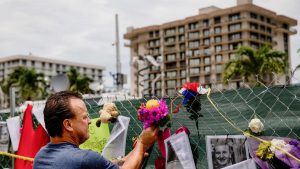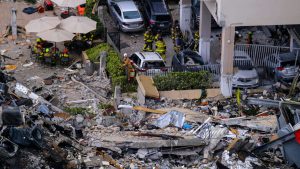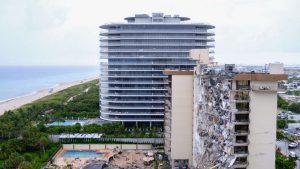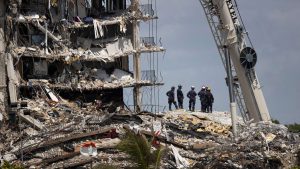JULY 4, 2021

Chris Jeffers placed flowers on a barricade fence that has become a makeshift memorial near the site of the Champlain Towers South collapse site in Surfside, Fla. – Scott McIntyre/NY Times
SURFSIDE, Fla. — Elena Blasser kept her two-bedroom, two-bath condo in the Champlain Towers South as a beachside gathering place for family reunions. She adored the ocean and the small town of Surfside, Fla., because they reminded her of homes in Cuba and Puerto Rico.

Pablo Rodriguez said his mother, Elena Blasser, broke into tears when she was asked to pay another special assessment. Scott McIntyre/NY Times
She sank at least $100,000 into renovations when she bought Penthouse 11 a little more than a decade ago. Then the complex’s problems began. Hairline cracks in the pool deck. Newly painted walls that chipped easily. Water pooling in the garage. To pay for it all, the monthly maintenance fees and special assessments grew.

Emergency workers assessing the building’s collapsed parking garage and pool deck. – Maria Alejandra Cardona/NY Times
“We’re paying those fees and where are they going?” Ms. Blasser, a 64-year-old former schoolteacher, kept telling her family and neighbors, according to her son Pablo Rodriguez.
Little did she know that the problems identified in the building were about to get much worse. A consultant’s report commissioned in 2018 had identified serious problems of crumbling concrete and corroded rebar — problems that engineers warned had already led to “major structural damage.”
Fixing it, the condo board eventually concluded, would cost an estimated $15 million. Ms. Blasser would have to come up with another $120,000 to pay her share.
Long before half of the Champlain Towers South crumpled to the ground on June 24, killing at least 24 people and leaving up to 121 unaccounted for — including Ms. Blasser and her mother, Elena Chavez, 88 — the rancor over how the building was run by its condominium association was an open secret known to the relatives and friends of the people who lived there, and even to residents of other nearby buildings.
It coexisted with the joys of the otherwise congenial community of condo dwellers who had been sold on the Florida dream of waterfront bliss. Emma Guara, 4, would stop John Turis, 76, by the pool to play with Leela, his Cavalier King Charles spaniel, when he was in town from Brooklyn. Ana and Juan Mora would swing by a neighbor’s unit on the 10th floor to see if she needed anything. Younger residents would look out for older ones when they waded into the ocean.
By the time the board members entrusted by their neighbors with overseeing the building hired an engineer to tell them what they had long suspected — that their aging condo was in dire need of top-to-bottom repairs — the meetings at the 13-story complex had developed a toxic reputation.

Residents of the Champlain Towers South complained about the nearby construction of Eighty Seven Park Miami. – Maria Alejandra Cardona/NY Times
“People said, ‘Oh my God, thank God you’re not at the board meeting,’” Sharon Schechter recalled. “‘There’s screaming and yelling.’”
Tense stalemates delayed any decisions as the board became a hothouse of grievance over who was to blame, according to interviews with survivors of the collapse, former residents, relatives of the missing, lawyers and internal documents obtained by The New York Times.

“Somebody can seriously be injured or killed with the state of the concrete,” Marcelo Pena said in a letter to the condo board in 2019. – Joe Raedle/Getty Images
Ms. Blasser’s frustration grew each year, Mr. Rodriguez said. In 2017, she paid $60,000 for a special assessment to help make repairs. Then came the latest one, Mr. Rodriguez said, breaking into tears.

Steve Rosenthal outside the Residence Inn, a few blocks from the collapse site, in the only set of clothes he has left after being rescued from the intact part of the building. – Scott McIntyre/NY Times
“She kept saying, ‘I can’t believe we have to do this again,’” he said.
In April, fed up, Ms. Blasser reached out to a real estate agent about selling her condo and was told it would sell quickly for close to a million dollars.
“She was anxious to get out,” said Taylor Corey, the agent, who never got to post the listing.
No one envisioned that, after 1:30 a.m. on June 24, the 40-year-old building that residents had so passionately squabbled over would be little more than a mountain of rubble and an unimaginable landscape of grief.
A vacation paradise becomes a home for families
Champlain Towers South, once mostly home to retirees and winter snowbirds, had lately begun drawing more year-round residents, including younger families. Surfside had evolved from a sleepy Miami Beach backwater to a desirable community on the rise. Amid a growing number of gleaming new condo towers, Champlain Towers South started to look dated.
The building was scheduled this year to undergo the full 40-year recertification that Miami-Dade County required of high-rises of that age.
Overseeing the review would be the condo board, an institution that, like condominium associations around the country, is a volunteer operation whose elected members often have no expertise in construction, finance or property management. They wield, with little oversight, enormous control over the shared lives of dozens of families who have elected to live under one roof.
The 2018 engineering report from Frank P. Morabito, the consulting engineer, was deeply troubling. He gave no indication that the structure was at risk of failing, but he estimated that repairs would cost more than $9 million.
The board invited Ross Prieto, Surfside’s building official, to a meeting. His presence reassured residents like Susana Alvarez.
“Prieto sat in front of us and said — his words — that the building is in very good shape,” she said.
Ms. Alvarez, 62, had bought Unit 1006 in 2009. Her mother’s best friend, Hilda Noriega, lived in Unit 602. Their families spent Christmases and vacations together, and Ms. Noriega had good things to say about the place.
“She said it was a great apartment, it was a great building,” Ms. Alvarez said. “It was a community. I thought I was going to retire there.”
Mr. Morabito’s report was concerning but did not appear to portend danger.
“We’re not engineers. They’re not engineers,” she said of the board.
Building was ‘trembling’ from construction next door
It was not only the prospect of huge repairs that roiled the residents. They also worried about a massive, Renzo Piano-designed residential tower known as Eighty Seven Park Miami that was going up next door, in the city of Miami Beach but practically on the Champlain Towers South lot line.
Residents repeatedly raised concerns that the construction was so close that their building kept shaking.
“When they were drilling for the piles, Champlain Towers was trembling,” said Spiros Dimitropoulos, a renter for five years.
On Jan. 23, 2019, Mara Chouela, a board member, emailed Mr. Prieto. “We have concerns regarding the structure of our building” because of the shaking, she said, asking if someone from the town would take a look.
“There is nothing for me to check,” Mr. Prieto responded. He said the residents should hire someone to monitor the fence, pool and other areas for damage.
Over the summer, board members focused on the problems identified by Mr. Morabito’s 2018 inspection. In an undated letter, the board told residents it was time for “a very candid discussion” about the building’s future.
“For the last few years, your board has recognized that our building has been neglected, repairs have been repeatedly postponed or simply patched up, and our property values have remained sadly below what they should be,” they wrote.
In the past three years, board members said, they had tried “in a responsible way” to start to get things done.
“Sadly a few of our residents have undermined our progress with petty challenges, discrediting the board members and management,” they said.
Mr. Turis, a real estate and mortgage broker in New York who bought Unit 409 in 2005 so his daughter could live in it while she attended college, said the building had been mired in turnover of board members and property managers.
“It was like nobody wanted the job,” he said. “It seemed like nobody ever lasted more than two years.”
On Sept. 13, 2019, Graciela M. Escalante, who chaired the committee in charge of the 40-year recertification project, recommended hiring Mr. Morabito’s firm to carry out the work, even though his bid was the most expensive and initially led to what the selection committee admitted was “sticker shock.”
The next day, Anette Goldstein, the board president, and Nancy K. Levin, the vice president, both resigned, saying they were frustrated by last-minute objections that kept derailing progress on repairs.
“This pattern has repeated itself over and over, ego battles, undermining the roles of fellow board members, circulation of gossip and mistruths,” Ms. Goldstein wrote. “I am not presenting a very pretty picture of the functioning of our board and many before us, but it describes a board that works very hard but cannot for the reasons above accomplish the goals we set to accomplish.”
Ms. Levin, who had lived in the building since it opened, said it had gone from being the “jewel” of Surfside to being overtaken by a “political battle of egos and power.”
A third board member, Maggie A. Manrara, the treasurer, resigned six days later, because she disagreed with other members who wanted to accept $400,000 from the developers of Eighty Seven Park to resolve their complaints, against the advice of the board’s lawyers. The board did not ultimately accept it.
In all, six of seven board members resigned, five of them in the two weeks leading up to Oct. 3, 2019. At a board meeting that day, Ms. Escalante and others laid out a slew of concerns. She was elected the new president and, as the building official for the neighboring village of Bal Harbour, she had real expertise for the job.
Another board member, Marcelo Pena, who owned Unit 708 as a vacation home, resigned on Oct. 23, 2019.
“The building is falling apart,” he wrote to the board the following month, accusing the previous members of prioritizing renovations to common-area bathrooms over structural repairs.
“Somebody can seriously be injured or killed with the state of the concrete,” he wrote.
Ms. Escalante did not last long. She resigned on Dec. 15, 2019, citing health concerns, and sold her condo nine months later.
‘We should have started saving at least five years ago’
New board members took over in 2020 and managed to do what none of their predecessors had: They secured a $15 million line of credit to pay for the repairs identified by Mr. Morabito in 2018. The project’s cost had grown upon closer inspection and as time passed.
In a series of slide show presentations, the board bluntly laid out the reality. “We should have started saving at least five years ago,” said one from May 28, 2020. An October 2020 presentation said further inspections had shown that the waterproofing problems over the garage were far more widespread than initially thought: “This has exposed the garage to water intrusion for 40 years.”
Despite its financial challenges, the building, with its close-up view of the South Florida surf, was desirable in the booming market, according to Andres Paredes, a real estate agent involved in a 2020 unit sale.
The condo management openly released details of the planned multimillion-dollar restoration to prospective buyers, he said. Even with the assessments that would surely be needed to cover the cost of repairs, Unit 202 seemed like a good investment to a New York couple. The price was $460,000.
Longtime residents, like Ms. Blasser, had already borne the brunt of repeated special assessments for other repairs. One of them, which had been intended for hallway renovations in 2016, had instead been repurposed to address budget shortfalls and help finance the big 40-year repairs.
They would have to dig deep for more money: Each unit would have to pay between $80,000 and about $200,000, either up front or in monthly installments.
No one was happy about it.
Steve Rosenthal, 72, a restaurant advertising executive, went to the gym in the building nearly every day. Afterward, he would stop at the pool, where he could see a crack on a third-floor balcony that he described as “atrocious.” But he called the $135,000 assessment on his condo, a corner unit with double balconies, a “second mortgage.”
“It’s an upscale building, but it’s not the Ritz or the Four Seasons,” he said. “The people that live there aren’t Rockefellers or Rothschilds. We’re upper middle class, I guess, and a lot of us are retired.”
When a neighbor knocked on his door, 705, with a petition against the assessment, Mr. Rosenthal signed it. The first payment was due on July 1.
In April, when the assessments went out, Jean Wodnicki, the new condo board president, laid out the damage in a letter to owners in much more serious language than before. The deterioration had “gotten significantly worse” since Mr. Morabito’s inspection, and without intervention, the concrete problems would “multiply exponentially.”
“A lot of this work could have been done or planned for in years gone by,” the condo board president, Ms. Wodnicki, conceded in a letter to residents in April. “But this is where we are now.”
In late April, Mr. Turis and his wife went to Surfside for a few weeks. They threw a big party on the balcony to celebrate his niece’s new baby.
“My wife said, ‘You know, we should come more often,’” he said. They planned a long weekend for the Fourth of July.
Sales at the complex kept booming. Seven units closed in 2021, fetching record prices. Penthouse A sold in May for $2.88 million. A real estate brokerage described the latest unit sold, 910, as a remodeled three-bedroom, two-bath with “breathtaking views.”
It closed on June 17 for $710,000. The unit was rented until July 30 to Betty and Gil Guerra, who had moved in only a few months earlier. They are still missing.
On June 23, Ms. Blasser, the former schoolteacher, heard creaking noises in her unit. They were loud enough to wake her up at around 3 a.m. and worrying enough to keep her awake, said Mr. Rodriguez, her son.
Around 1:15 a.m. the next morning, a tourist staying at a nearby hotel heard a loud noise, she told The Miami Herald. She peered through the entrance of the Champlain Towers South’s parking garage, saw concrete chunks falling to the floor and recorded video of water pouring in.
Just before 1:30 a.m., Cassie Stratton, 40, was on the phone with her husband, Michael Stratton. She looked out through the window of Unit 412 when, she told him, a hole started opening near the pool.
Then the line went dead.
Courtesy/Source: NY Times

































































































